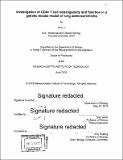Investigation of CD4+ T cell heterogeneity and function in a genetic mouse model of lung adenocarcinoma
Author(s)
Li, Amy
DownloadFull printable version (25.21Mb)
Other Contributors
Massachusetts Institute of Technology. Department of Biology.
Advisor
Tyler Jacks.
Terms of use
Metadata
Show full item recordAbstract
The clinical success of immune checkpoint blockade in the treatment of various cancers provides proof-of-concept that disrupting tumor immune tolerance is an effective therapeutic strategy. Nevertheless, only a subset of patients respond to immune therapies, suggesting that an improved understanding of immunosuppressive mechanisms is needed. CD4+ T cells, which are phenotypically diverse, orchestrate many diverse components of immune responses, and can contribute to tumor growth through a variety of mechanisms. Regulatory T cells (Tregs) in particular are an immunosuppressive subpopulation of CD4+ T cells that may play a central role in immune tolerance to tumors. Targeted manipulation of tumor-promoting CD4+ T cells could augment the efficacy of existing immunotherapies, but our understanding of the complexity and evolution of tumoral CD4+ T cell responses is limited. We sought to characterize the transcriptional features of tumor-associated CD4+ T cells in order to identify pathways that may be used to inhibit their tumor-promoting functions. Using population and single-cell RNA sequencing, we longitudinally profiled conventional CD4+ T (Tconv) and Tregs in an inducible genetic mouse model of lung adenocarcinoma. We show that lung tumor-associated Tregs have a distinct transcriptional signature that is associated with survival in multiple cancers. Furthermore, we find that tumor-associated Treg and Tconv cells are varied and undergo shifts in gene expression that may represent strengthening immunosuppression as tumors progress. For example, a heterogeneous population of type 1 (Th1) cells is present throughout tumor development but adopts more characteristics that may be associated with immunosuppressive activity at late timepoints. Similarly, early Tregs appear more flexible and express genes associated with Tconv cells, but a terminally-differentiated effector Treg phenotype becomes predominant at late timepoints. We identified ST2 as a potential mediator of effector Treg differentiation or expansion in tumors. Through IL-33 administration and Treg-specific genetic ablation of ST2 we find that IL-33 signaling may be necessary and sufficient for increased numbers of terminally-differentiated effector Tregs during tumor progression. Taken together, our insight on the evolution of CD4+ T cell heterogeneity in tumors provides a window into the natural history of tumor immunosuppression and may reveal critical mediators of the tumor immune response.
Description
Thesis: Ph. D., Massachusetts Institute of Technology, Department of Biology, 2018. Cataloged from PDF version of thesis. Vita. Includes bibliographical references.
Date issued
2018Department
Massachusetts Institute of Technology. Department of BiologyPublisher
Massachusetts Institute of Technology
Keywords
Biology.